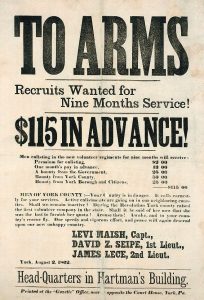Recruiting the Regiment: York County and the 130th Pennsylvania Infantry

In previous blog posts, I explored the service of the 130th Pennsylvania Infantry at Antietam as well as at Fredericksburg and Chancellorsville. In this post, part of ECW’s larger “Recruiting the Regiment” series, I’ll take a step back from the battle narratives and explore the creation of this unit. Since the 130th was a nine-month regiment, their recruitment and service is a little different than the traditional story. Most soldiers in the United States army enlisted for terms of three years, especially after the first year of the war. However, manpower necessities that were often exacerbated by times of crisis led to units sometimes being raised for shorter terms. The recruitment of the 130th Pennsylvania also occurred in the shadow of threats of a draft. During summer 1862, the federal government requested an additional 150,000 volunteers, and any state that did not raise an assigned quota by August 15 would be subject to a militia draft.[1] Officials hoped that shorter commitments would induce volunteers without resorting to an unpopular draft if quotas were not met, but little did volunteers joining the 130th Pennsylvania know that their brief term would involve combat in three of the war’s deadliest battles.
In addition to the shorter term, bounty payments provided extra enticement. A recruitment poster for Captain Levi Maish’s Company K, raised in York County, lists various bounties from the national government, the county, and the borough of York that totaled $115 – a sizeable sum since privates made $13 a month. York officials and citizens had gathered together and raised significant bounties in hopes of avoiding a draft by inducing enough volunteers to meet their quota. Though nine-month enlistments and bounties may have tipped the scales, we should not discount patriotism and duty as motivators for the 130th Pennsylvania. Though Mark Snell suggested that the draft was a meaningful motivation for the boom of volunteers for the 130th Pennsylvania, when Terrence Beltz examined primary sources from the regiment he found numerous references to loyalty and duty and no open mention of enlisting “merely to avoid the draft.”[2] The same recruiting poster that listed bounties also appealed to patriotism, calling out “During the Revolution York county raised the first volunteer company in the state. Shall it be said of her now that she was the last to finish her quota! Arouse then! Awake, and to your county’s rescue fly.” Through this, recruiting officers called back to a Revolution-era volunteer legacy while also addressing local pride.

Ultimately, York found success through their patriotic and financial appeals. The York Gazette proudly proclaimed that by the deadline of August 15 the county had raised more than their quota of three companies. Most recruits from York County had joined Companies B, I, or K in the 130th Pennsylvania Infantry, which was soon assigned to the Second Brigade, Third Division, Second Corps of the Army of the Potomac and engaged at the battle of Antietam less than a month after starting service. Many of these volunteers were wounded or killed at battles across Virginia and Maryland or succumbed to illness or disease. However, many others, including my ancestor Jacob Reever of Company K returned safely home to York in May 1863 to a warm reception replete with a parade, ringing church bells, and a meal.[3] Whether enticed by shorter terms, bounties, or patriotism, those who had enlisted in the regiment nine long months prior likely found their service far different than their expectations.
[1] Terrence W. Beltz, “The History of the One Hundred and Thirtieth Regiment, Pennsylvania Volunteer Infantry” University of Richmond Master’s Theses, 7.
[2] Mark A. Snell, Union Soldiers and the Northern Home Front (New York: Fordham University Press, 2002), 82-82, and Beltz, 1-2.
[3] Edward W. Spangler, My Little War Experience with Historical Sketches and Memorabilia (York, PA: York Daily Publishing Company, 1904). Edward Spangler also served in Company K, and his book includes his wartime narrative as well as appendices of various documents such as newspapers clippings from York about recruitment.

2 Responses to Recruiting the Regiment: York County and the 130th Pennsylvania Infantry